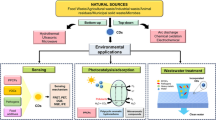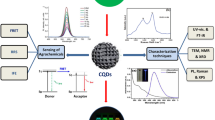Abstract
Silicon nanoparticles (SiNPs) modified with Eu(III) were synthesized and are shown to be a viable ratiometric fluorescent probe for tetracycline antibiotics. SiNPs/Eu under 405 nm excitation display two emissions, viz. a strong cyan colored fluorescence peaking at 497 nm and a weak pink fluorescence peaking at 622 nm. On addition of tetracyclines (chlortetracycline, tetracycline, doxycycline), the fluorescence at 497 nm is reduced, while the one at 622 nm is increased. Thus, the visible color of fluorescence changes from cyan to pink. This was exploited to design ratiometric fluorometric method for detecting tetracyclines. The method has a limit of detection that is lower by a factor of about 1000 when compared to the use of SiNPs only. A test paper was prepared with the SiNPs/Eu and then applied for the visual semi-quantitative detection of tetracyclines. With the addition of tetracyclines, the test paper exhibited a dosage-sensitive color conversion from cyan to pink with a visually discernible scale as low as 0.4 μM.

Tetracyclines decrease the fluorescence at 497 nm of europium (III) modified silicon nanoparticles (SiNPs/Eu) due to the inner filter effect and increase the one at 622 nm due to an antenna effect. Thus the fluorescence color of SiNPs/Eu changes from cyan to pink. Based on this color switch, a ultrasensitive and visual determination strategy for tetracyclines is proposed.





Similar content being viewed by others
References
Ibarra IS, Rodriguez JA, Miranda JM, Vega M, Barrado E (2011) Magnetic solid phase extraction based on phenyl silica adsorbent for the determination of tetracyclines in milk samples by capillary electrophoresis. J Chiromatogr A 1218:2196–2202. https://doi.org/10.1016/j.chroma.2011.02.046
Mookantsa SOS, Dube S, Nindi MM (2016) Development and application of a dispersive liquid-liquid microextraction method for the determination of tetracyclines in beef by liquid chromatography mass spectrometry. Talanta 148:321–328. https://doi.org/10.1016/j.talanta.2015.11.006
Chen YN, Kong DZ, Liu LQ, Song SS, Kuang H, Xu CL (2016) Development of an ELISA and immunochromatographic assay for tetracycline, oxytetracycline, and chlortetracycline residues in milk and honey based on the class-specific monoclonal antibody. Food anal method 9:905–914. https://doi.org/10.1007/s12161-015-0262-z
Lian WJ, Huang JD, Yu JH, Zhang XM, Lin Q, He XR, Xing XR, Liu S (2012) A molecularly imprinted sensor based on β-cyclodextrin incorporated multiwalled carbon nanotube and gold nanoparticles-polyamide amine dendrimer nanocomposites combining with water-soluble chitosan derivative for the detection of chlortetracycline. Food Control 26:620–627. https://doi.org/10.1016/j.foodcont.2012.02.023
Chen XM, Zhao LM, Tian XT, Lian S, Huang ZY, Chen X (2014) A novel electrochemiluminescence tetracyclines sensor based on a Ru(bpy)3 2+-doped silica nanoparticles/nafion film modified electrode. Talanta 129:26–31. https://doi.org/10.1016/j.talanta.2014.04.054
Yan PC, Jiang DS, Tian YH, Xu L, Qian JC, Li HN, Xi JX, Li HM (2018) A sensitive signal-on photoelectrochemical sensor for tetracycline determination using visible-light-driven flower-like CN/BioBr composites. Biosens Bioelectron 111:74–81. https://doi.org/10.1016/j.bios.2018.03.054
Li HH, Chen QS, Hassan MM, Chen XX, Ouyang Q, Guo ZM, Zhao JW (2017) A magnetite/PMAA nanospheres-targeting SERS aptasensor for tetracycline sensing using mercapto molecules embedded core/shell nanoparticles for signal amplification. Biosens Bioelectron 92:192–199. https://doi.org/10.1016/j.bios.2017.02.009
Li HD, Yao QC, Xu F, Xu N, Ma XC, Fan JL, Long SR, Du JJ, Wang JY, Peng XJ (2018) Recognition of exogenous and endogenous nitroxyl in living cells via a two-photon fluorescent probe. Anal Chem 9:4641–4648. https://doi.org/10.1021/acs.analchem.7b05172
Mao SE, Yuan QX, Kong XL, Chen XW, Wang JH (2018) Targeted imaging of lysosome and endoplasmic reticulum and their pH monitoring with surface regulated carbon dots. Nanoscale 10:12788–12796. https://doi.org/10.1039/C8NR03453B
Li DX, Qin J, Xu Q, Yan GQ (2018) A room-temperature phosphorescence sensor for the detection of alkaline phosphatase activity based on Mn-doped ZnS quantum dots. Sensor Actuat B: Chem 274:78–84. https://doi.org/10.1016/j.snb.2018.07.108
Yang YX, Huo DQ, Wu HX, Wang XF, Yang JS, Bian MH, Ma Y, Hou CJ (2018) N,P-doped carbon quantum dots as a fluorescent sensing platform for carbendazim detection based on fluorescence resonance energy transfer. Sensor Actuat B: Chem 274:296–303. doi:https://doi.org/10.1016/j.snb.2018.07.130, N, P-doped carbon quantum dots as a fluorescent sensing platform for carbendazim detection based on fluorescence resonance energy transfer
Lin BX, Yu Y, Cao YJ, Guo ML, Zhu DB, Dai JX, Zheng MS (2018) Point-of-care testing for streptomycin based on aptamer recognizing and digital image colorimetry by smartphone. Biosens Bioelectron 100:482–489. https://doi.org/10.1016/j.bios.2017.09.028
Zhou YJ, Huang XY, Liu C, Zhang RL, Gu XL, Guan GJ, Jiang CL, Zhang LY, Du SH, Liu BH, Han MY (2016) Color-multiplexing-based fluorescent test paper: dosage-sensitive visualization of arsenic(III) with discernable scale as low as 5 ppb. Anal Chem 88:6105–6109. https://doi.org/10.1021/acs.analchem.6b01248
Chao MR, Hu CW, Chen JL (2014) Comparative syntheses of tetracycline-imprinted polymeric silicate and acrylate on CdTe quantum dots as fluorescent sensors. Biosens Bioelectron 61:471–477. https://doi.org/10.1016/j.bios.2014.05.058
Ji Y, Lin ZZ, Nur AZ, Lu Y, Wu MH, Zeng J, Chen XM, Huang ZY (2018) Detection of trace tetracycline in fish via synchronous fluorescence quenching with carbon quantum dots coaated with molecularly imprinted silica. Spectrochim Acta A 190:450–456. https://doi.org/10.1038/s41598-017-02983-8
Zhong YL, Peng F, Bao F, Wang SY, Ji XY, Yang L, Su YY, Lee ST, He Y (2013) Large-scale aqueous synthesis of fluorescent and biocompatible silicon nanoparticles and their use as highly photostable biological probes. J Am Chem Soc 135:8350–8356. https://doi.org/10.1021/ja4026227
Ye HL, Cai SJ, Li S, He XW, Li WY, Li YH, Zhang YK (2016) One-pot microwave synthesis of water-dispersible, high fluorescence silicon nanoparticles and their imaging applications in vitro and in vivo. Anal Chem 88:11631–11638. https://doi.org/10.1021/acs.analchem.6b03209
Han YX, Chen YL, Feng J, Liu JJ, Ma SD, Chen XG (2017) One-pot synthesis of fluorescent silicon nanoparticles for sensitive and selective determination of 2,4,6-trinitrophenol in aqueous solution. Anal Chem 89:3001–3008. https://doi.org/10.1021/acs.analchem.6b04509
Ma SD, Chen YL, Feng J, Liu JJ, Zuo XW, Chen XG (2016) One-step synthesis of water-dispersible and biocompatible silicon nanoparticles for selective heparin sensing and cell imaging. Anal Chem 88:10474–10481. https://doi.org/10.1021/acs.analchem.6b02448
Xu N, Yuan YQ, Yin JH, Wang X, Meng L (2017) One-pot hydrothermal synthesis of luminescent silicon-based nanoparticles for highly specific detection of oxytetracycline via ratiometric fluorescent strategy. RSC Adv 7:48429–48436. https://doi.org/10.1039/C7RA09338A
Chu BB, Song B, Ji XY, Su YY, Wang HY, He Y (2017) Fluorescent silicon nanorods-based ratiometric sensors for long-term and real-time measurements of intracellular pH in live cells. Anal Chem 89:12152–12159. https://doi.org/10.1021/acs.analchem.7b02791
Wang S, Yong W, Liu JH, Zhang LY, Chen QL, Dong YY (2014) Development of an indirect competitive assay-based aptasensor for highly sensitive detection of tetracycline residue in honey. Biosens Bioelectron 57:192–198. https://doi.org/10.1016/j.bios.2014.02.032
Qu F, Sun Z, Liu DY, Zhao XN, You JM (2016) Direct and indirect fluorescent detection of tetracyclines using dually emitting carbon dots. Microchim Acta 183:2547–2553. https://doi.org/10.1007/s00604-016-1901-9
Hu Q, Li W, Qin CQ, Zeng LT, Hou JT (2018) Rapid and visual detection of benzoyl peroxide in food by a colorimetric and ratiometric fluorescent probe. J Agric Food Chem 66:10913–10920. https://doi.org/10.1021/acs.jafc.8b04733
Chen BB, Liu ML, Zhan L, Li CM, Huang CZ (2018) Terbium (III) modified fluorescent carbon dots for highly selective and sensitive ratiometry of stringent. Anal Chem 90:4003–4009. https://doi.org/10.1021/acs.analchem.7b05149
Zu FL, Yan FY, Bai ZJ, Xu JX, Wang YY, Huang YC, Zhou XG (2017) The quenching of the fluorescence of carbon dots: a review on mechanisms and applications. Microchim Acta 184:1899–1914. https://doi.org/10.1007/s00604-017-2318-9
Yang KC, Wang SS, Wang YY, Miao H, Yang XM (2017) Dual-channel probe of carbon dots cooperating with gold nanoclusters employed for assaying multiple targets. Biosens Bioelectron 91:566–573. https://doi.org/10.1016/j.bios.2017.01.014
Wolfbeis OS, Durkop A, Wu M, Lin ZH (2002) A europium-ion-based luminescent sensing probe for hydrogen peroxide. Angew Chem Int Ed 41:4495–4498. https://doi.org/10.1002/1521-3773(20021202)41:23<4495::AID-ANIE4495>3.0.CO;2-I
Xu J, Shen XK, Jia L, Zhou T, Ma TL, Xu ZQ, Cao JL, Ge ZL, Bi N, Zhu TF, Guo SL, Li XH (2018) A novel visual ratiometric fluorescent sensing platform for highly-sensitive visual detection of tetracyclines by a lanthanide-functionalized palygorskite nanomaterial. J Hazard Mater 342:158–165. https://doi.org/10.1016/j.jhazmat.2017.08.020
Li WY, Zhu JC, Xie GC, Ren YK, Zheng YQ (2018) Ratiometric system based on graphene quantum dots and Eu3+ for selective detection of tetracyclines. Anal Chim Acta 1022:131–137. https://doi.org/10.1016/j.aca.2018.03.018
Shen Z, Zhang C, Yu XL, Li J, Wang ZY, Zhang ZP, Liu BH (2018) Microwave-assisted synthesis of cyclen functional carbon dots to construct a ratiometric fluorescent probe for tetracycline detection. J Mater Chem C 6:9636–9641. https://doi.org/10.1039/C8TC02982B
Zhang H, Chen HY, Pan S, Yang H, Yan JJ, Hu XL (2018) Development of an optical sensor for chlortetracycline detection based on the fluorescence quenching of L-tryptophan. Luminescence 33:196–201. https://doi.org/10.1002/bio.3393
Wang P, Wu TH, Zhang Y (2016) Novel silver nanoparticle-enhanced fluorometric determination of trace tetracyclines in aqueous solutions. Talanta 146:175–180. https://doi.org/10.1016/j.talanta.2015.07.065
Acknowledgements
The work was supported by the National Natural Science Foundation of China (Nos. 21575043, 21275056, 21605052, 51478196); and the Platform Construction Project of Guangzhou Science Technology and Innovation Commission (No. 15180001).
Author information
Authors and Affiliations
Corresponding author
Ethics declarations
The author(s) declare that they have no competing interests.
Additional information
Publisher’s note
Springer Nature remains neutral with regard to jurisdictional claims in published maps and institutional affiliations.
Electronic supplementary material
ESM 1
(DOC 679 kb)
Rights and permissions
About this article
Cite this article
Lin, B., Zhang, T., Xin, X. et al. Europium(III) modified silicone nanoparticles for ultrasensitive visual determination of tetracyclines by employing a fluorescence color switch. Microchim Acta 186, 442 (2019). https://doi.org/10.1007/s00604-019-3557-8
Received:
Accepted:
Published:
DOI: https://doi.org/10.1007/s00604-019-3557-8




